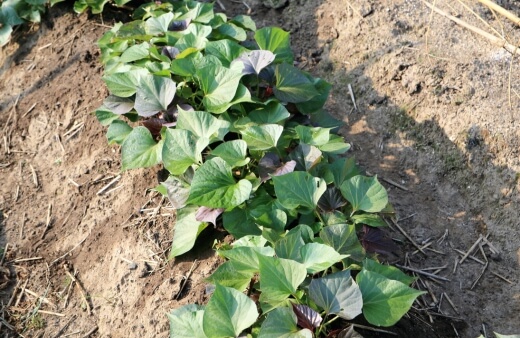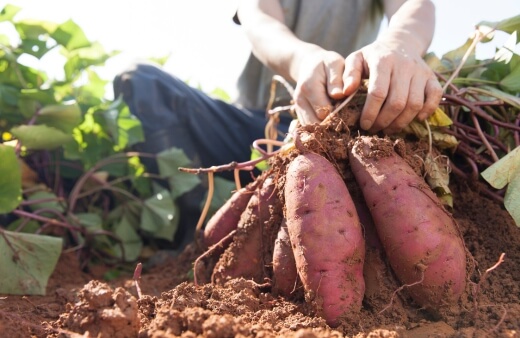The sweet potato is one of my all-time favourite vegetables. It’s hearty and healthy, and there is so much you can do with it in the kitchen. Our sweet potato guide looks at sweet potato planting, growing sweet potato including how to care for them, some propagation guidelines, and tips on how to cure and store this root vegetable.
More...

Family: | Convolvulaceae |
|---|---|
Genus: | Ipomoea |
Species: | I. batatas |
Origin: | Central and South America |
Common Names: | Sweet potato |
Location: | Outdoor |
Type: | Root vegetable, vine |
Growth: | Up to 30 cm tall and 1 metre wide |
Sun requirements: | Full sun |
Foliage Colour: | Yellow-green, purple |
Flower Colour: | White and purple but they don’t always flower |
Flowering: | Spring in their second year |
Edible Parts: | Large edible root |
Maintenance level: | Average |
Poisonous for pets: | No |
Introducing Sweet Potato
Sweet potato is considered a tropical plant and is actually related to the morning glory family. You might notice similarities when looking at the sweet potato leaves and flowers. Sweet potatoes are not actually related to potatoes, as they are part of the nightshade family.
(Find out more about growing potatoes here.)
The part of the sweet potato that we eat is a root, whereas the everyday potatoes that we know are tubers. Sweet potatoes are an incredibly healthy vegetable, and were actually used as part of folk remedies once upon a time for the treatment of asthma and diarrhoea.
You’ll recognise sweet potato by its dark orange colour on the inside and a skin that is more a copper colour. This root vegetable is usually enjoyed mashed up or roasted as is.
Growing Sweet Potatoes in Australia
Sweet potatoes are not grown from seeds but rather from slips. These are sprouts that grow from an existing sweet potato. In terms of growing time, they usually take between 90 and 120 days to reach maturity.

Propagating Sweet Potato
If you want to grow your own slips for planting, go and buy some sweet potatoes from a market or store. Try and make sure they are smooth with no blemishes and organic if possible. Pop the entire sweet potatoes into a pot or container with at least 8 cm of organic and well-draining soil.
You can space the sweet potatoes about 5 cm apart. Lightly cover them with some more soil, water it, and then top up with water as needed to keep the soil damp. It should never be soggy. Sweet potatoes enjoy a warm temperature so try and keep the soil and room where they are being stored comfortable.
You’ll soon see shoots or slips popping out of the soil. Within 8 weeks they will be at least 15 cm long and will have some leaves and roots. You can remove the slips from the sweet potatoes, roots and all.
In the case that the slip doesn’t have roots, you can remove it, pop it in some water, and you should have roots in about 2 weeks. When you are ready to plant the slips outside, you can harden them off first for about 2 weeks by letting them enjoy some partial sunlight outdoors each day.
Planting, Growing and Caring for Sweet Potato

Planting Sweet Potatoes
You can plant your sweet potato slips outdoors once the soil is warm enough, around 18°C, and the temperature at night shouldn’t be less than 13°C.
Young sweet potatoes need to be protected from cold temperatures as they are delicate. You could cover them up at night and then remove the covering during the day.
Create raised beds for planting and allow enough space between each one for the vines to grow. Try to plant the slips on a warm day and overcast if possible. You can remove the lower leaves so that just the top ones remain.
The slips need to be planted deep enough so that the roots are covered and also the stem up to where the leaves emerge. Make sure you provide plenty of water for about 10 days as this helps the plant to root itself.
Best Conditions for Growing and Caring for Sweet Potato
Sweet potatoes enjoy full sun, so choose somewhere sunny and make sure to use well-draining soil. A sandy soil is first prize, but if you have soil that is more compact, you can plant in raised beds.
You can add compost and perlite to the soil, just don’t use any animal manure as it affects the roots of the plant. Beware of fertilisers that are heavy on the nitrogen. They will create plenty of leaf growth but this takes away from the development of the edible sweet potato root.
Apply a 5-10-10 fertiliser about 4 weeks after planting and be sure to weed the soil often. Just be aware of the delicate roots if you are using any gardening tools for weeding.
Water your sweet potato plant often, especially in the height of summer when the weather is hot and dry. Later in the season you can then cut back on the watering otherwise you might cause the skin of the sweet potato to crack.
Sweet potato vines don’t need any pruning and can be left to grow enthusiastically.
Harvesting Sweet Potato
You can harvest your sweet potatoes when you notice that the leaves and tips of the vine have become yellow. Loosen up the soil surrounding the plant to help protect the roots and you can remove some of the vines.
Pull up the main crown of the plant and then you can use your hands to dig up the roots. Give it a shake to get rid of excess dirt but don’t wash the roots.

How to Store Sweet Potatoes
We recommend curing sweet potatoes if you want them to develop a sweeter taste. This process also encourages a second skin to form on the sweet potato which evens out any scratches or bruising. Sweet potatoes are known to bruise very easily.
The curing process is quite simple – space out the sweet potatoes so they don’t touch each other and put them somewhere warm and with high humidity for about 2 weeks.
Once curing is complete, you can then individually wrap the sweet potatoes in newspaper and pack them into a box to be stored at a high humidity and with an even temperature. The sweet potatoes can be stored like this for up to 6 months.
Pests and Diseases to Look Out For
Flea beetles
This insect creates lots of tiny holes in the leaves. You can try covering your sweet potatoes, add lots of mulch, and try to include some native plants in your garden to attract helpful insects that keep the flea beetles under control.
Fusarium wilt (stem rot)
This fungus causes yellow leaves that start to pucker, and the old leaves begin to drop off. You might notice that the vines are wilting and it can cause eventual plant death. The stems sometimes have a slight blue colour. You’ll need to destroy the infected plant unfortunately.
White rust
The fungus causes white blisters to appear on the underneath of the leaves, and yellow to green spots on the top of the leaves. Again, remove and destroy the infected plants and be sure to weed well. Just a reminder to disinfect all tools used.
Whiteflies
These insects secrete a sticky honeydew which then creates sooty black mould. You might see parts of the leaves turning yellow or silver. Whiteflies can cause wilting and stunted growth and they transmit viruses too.
Prune off the affected leaves and you can spray the leaves with water to help remove the pests. You can maintain treatments with an insecticidal soap or neem oil for a more natural option. If possible, try to attract helpful insects or birds.
Get to know more about whiteflies and how to get rid of them here.
Frequently Asked Questions

Can you substitute white potatoes for sweet potatoes when cooking?
The answer is no as potatoes are tubers and sweet potatoes are roots.
What is the difference between sweet potato and yams?
People often use this name interchangeably but these two are not related. Yams are underground tubers.
Is sweet potato really the most nutritious vegetable?
It definitely ranks highly in terms of nutrition and has more nutrients than spinach or broccoli.
What are some of the health benefits of sweet potato?
They contain very high levels of vitamin A, vitamin C, iron, potassium and fibre. Thanks to plenty of beta-carotene in sweet potatoes, they can help reduce cancer risk.
Are sweet potatoes a good choice for those watching their weight?
The great news is that sweet potatoes have almost zero fat. They are low in carbohydrates and high in fibre, which means you feel fuller for longer.
Where do sweet potatoes grow the best?
Sweet potatoes will grow best in the warmer parts of the country as they don’t like the cold.
Sign up for our newsletter for more gardening tips and inspiration.
Wrapping Up Our Guide to Growing, Harvesting, and Storing Sweet Potato
Sweet potatoes are rather impressive. They aren’t just nutritious, but are easy to grow and harvest. Thanks to the tropical origin of the sweet potato, they are known for handling drought and heat like champions.
It also helps that pests and disease don’t bother them too much. What are you waiting for? Start growing sweet potatoes today.
Published on April 28, 2023 by Maisie Blevins
Last Updated on February 25, 2024




